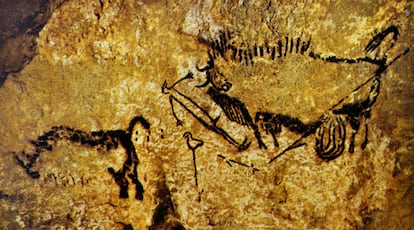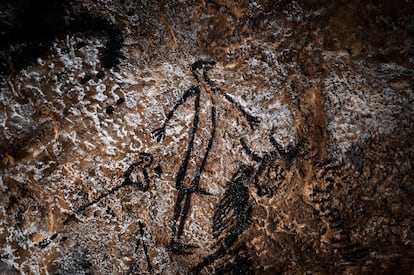The enigma of the Lascaux Bird Man: The erection that embodies the mysteries of prehistoric art
A wall painting depicting a dead man alongside a bison and rhinoceros has intrigued researchers since it was discovered in 1940

During World War II in France, in 1940, a dog named Robot changed the narrative of prehistory and, therefore, of humanity. The animal entered a cavity and was followed by four teenagers—one of them a young Jew who had fled to the unoccupied zone after the Nazi invasion. Inside they discovered the impressive group of cave paintings of Lascaux, and among these, the strangest, most disturbing and bewildering scene of prehistoric art.
The French cave complex houses nearly 2,000 drawings, depicting all the fauna of the time (364 horses, 90 deer...). The so-called Hall of the Bulls, 17 meters long by 6 meters wide, is as impressive as that of the bison in Spain’s Altamira cave: thousands of years ago, in different parts of the world, human creativity was immense and unstoppable. Henri Breuil, a Catholic priest who had been drawing prehistoric art for years, quickly came to the site. He, too, had fled from Paris and had taken refuge a few kilometers from Montignac, the nearest town to Lascaux. But the cave housed a strange drawing that was going to give many a headache to l’Abbé Breuil, as he was known. Since then, it has triggered hundreds of different interpretations and still remains a challenge for researchers.
Around 18,000 years ago, at a depth of five meters, in a well with a significant amount of carbon dioxide, someone used black paint to depict the following scene: a man with his mouth wide open, or else with a bird’s head, is lying on his back with an obvious erection, next to a bison pierced by a spear with its guts hanging out. At his side, he has a staff with a bird drawn on top. To the left of the scene there is a rhinoceros with six points arranged at the level of the anus (is it defecating on the recumbent man?). It is a strange scene, first, because in the prehistoric art of that period, human beings are hardly represented at all: animals were the main subject matter. Only much later did people show up. And, second, it is strange because of the thousand story possibilities offered by the scene.

The French prehistorian Jean-Loïc Le Quellec, one of the leading experts in parietal art with extensive experience in the Sahara, has published the book L’homme de Lascaux et l’énigme du puits (“The Lascaux man and the enigma of the well”), in which he tried to compile all the theories that have arisen since the drawing was discovered: Is it related to shamanism? Is it a scene recounting a hunt gone wrong? Is the bird-shaped stick meant to propel a spear or is it a wizard’s staff? Does it reflect something imagined or something real? Is it a birdman or a dead man with his mouth open? And, above all, what does the erect penis mean? Of course, in the first reproduction he made of the drawing in 1941, the priest Breuil “forgot” about the penis and in the first published photo, that same year, that part was erased in such a way that it remains as a black stain between the man and the bison.
The French philosopher Georges Bataille, who published an essay on Lascaux in 1955, wrote a lot about the Man in the Well. “The scene has an erotic nature, clearly underlined, although inexplicable,” he wrote. The French writer and critic Philippe Sollers asserted that this drawing represented “one of the deepest and most tragic enigmas of humanity.” “Whoever has seen it is marked forever by that cry of silence.” Its importance resides precisely in the fact that it questions us, in that this enigmatic and violent drawing symbolizes everything we do not know about prehistoric art: we can classify it, admire it, reproduce it, but we will never know what it means.
“All the interpretations of the Well Scene force us to ask ourselves about the way we contemplate the art of our ancestors,” writes Le Quellec in his essay. And in this way, the works that our predecessors traced on the walls of the caves come to life.” The beauty of prehistoric art resides in its enduring mystery, in the infinity of questions it raises. Something, surely, applicable to all art.
Sign up for our weekly newsletter to get more English-language news coverage from EL PAÍS USA Edition
Tu suscripción se está usando en otro dispositivo
¿Quieres añadir otro usuario a tu suscripción?
Si continúas leyendo en este dispositivo, no se podrá leer en el otro.
FlechaTu suscripción se está usando en otro dispositivo y solo puedes acceder a EL PAÍS desde un dispositivo a la vez.
Si quieres compartir tu cuenta, cambia tu suscripción a la modalidad Premium, así podrás añadir otro usuario. Cada uno accederá con su propia cuenta de email, lo que os permitirá personalizar vuestra experiencia en EL PAÍS.
¿Tienes una suscripción de empresa? Accede aquí para contratar más cuentas.
En el caso de no saber quién está usando tu cuenta, te recomendamos cambiar tu contraseña aquí.
Si decides continuar compartiendo tu cuenta, este mensaje se mostrará en tu dispositivo y en el de la otra persona que está usando tu cuenta de forma indefinida, afectando a tu experiencia de lectura. Puedes consultar aquí los términos y condiciones de la suscripción digital.
More information
Archived In
Últimas noticias
Welcome to the post-religion era: The idea of Christianity as the absolute truth has become obsolete
‘I thought you would like it’: The risky sexual practice popularized by TV shows and TikTok
The digitalization of tourism: ‘They promise experiences and gave us the worst possible one’
Mexican peso defies uncertainty with forecasts of a new period of stability in 2026
Most viewed
- Sinaloa Cartel war is taking its toll on Los Chapitos
- Oona Chaplin: ‘I told James Cameron that I was living in a treehouse and starting a permaculture project with a friend’
- Reinhard Genzel, Nobel laureate in physics: ‘One-minute videos will never give you the truth’
- Why the price of coffee has skyrocketed: from Brazilian plantations to specialty coffee houses
- Silver prices are going crazy: This is what’s fueling the rally









































